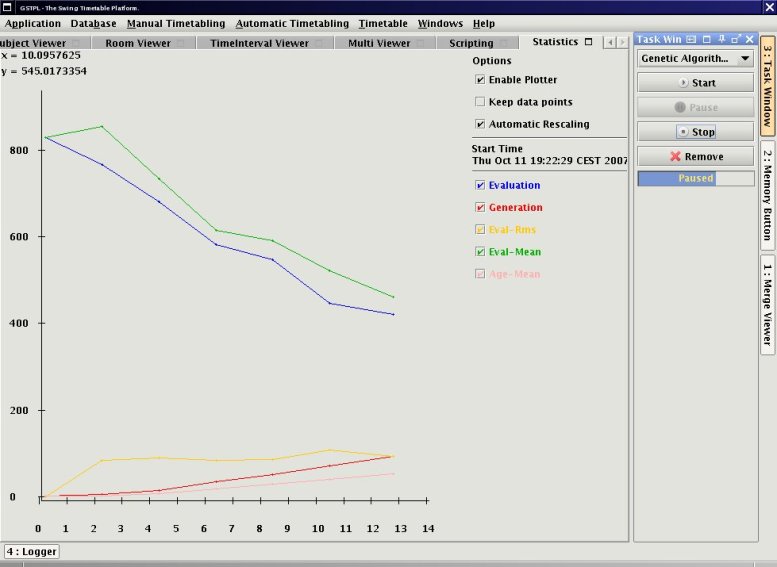The User Guide
About
The Swing Timetable Platform is a timetable generator for universities, highschools and even companies. In its current release gstpl supports manual timetabling as well as automatic scheduling:
- 'Manual Timetabling': You can look for free time slots for some persons (the selected persons in the list) even with respect to some rooms.
- 'Automatic Timetabling': You have to set some parameters and gstpl will optimize the resulting timetable of all involved persons and even rooms. gstpl optimizes the collisions and the gaps of the timetables.
Here you can see gstpl while optimizing the randomly generated timetable:

Introduction
You have to know what the basic objects in gstpl are:- Person: has a name and chooses some subjects.
- Subject: is a list of TimeInterval's. So you can manage a task here and split it into several time slots.
- TimeInterval: is a time slot with a starting time and a duration. It has a subject and a room where it takes place.
- Room: the place of a TimeInterval.
Before proceeding with automatic generation of the timetable or manual timetabling you should create manually all your objects.
If you want to clear the database (which could be filled with gstpl sample objects) go to the Database menu and click 'Remove All'.
After that you can go to the PersonList and create new persons.
Create Persons
- Click [New]
- Double click one column of the person. E.g. the name, then you can change this!
- Now you can add subjects: specify the subject click 'add subject'.
Generally you can do the following in such a basic-object-list:
- New will add a new default entry (person, subject or room) to the database.
- Edit an entry with: select and click into the property cell of the row.
- Remove will remove the selected entries from all other entries AND remove it from database.
- View Let it checked, if you want see immediately after you select an entry, what the time intervals are. Deselect if you have performance problems.
- Select all entries with [Ctrl]+[a].
- Count TI, will counts the TimeInterval's of the current visible timetable.
In the RoomList and SubjectList you can
- Create a new TimeInterval with specified room, specified subject and current inputs in 'Start Time', 'Duration' and 'Day'.
- Remove an existent TimeInterval with 'Remove TimeInterval'. The TimeInterval will be removed from subject's and room's timetable, too.
In the PersonList you can
- Add Subject, which will add the selected subject with all its TimeInterval's to the current person.
- Remove Subject, which will remove all TimeInterval's of the specified subject from the selected person's timetable! Not only one TimeInterval like it is the case in Room and SubjectViewers. And be sure that you remove the correct one, because you can't undo the removal!
Manual Timetabling (Manual TT)
Find Free Time Slots of Some Persons
- Select several persons.
- Press Calculate in menu bar 'Find Persons Free Time'.
- Type in the required time.
- Now you will see all available timeintervals in mergeviewer.
Find Occupied Time Slots of Some Persons
- Create several persons.
- Select some persons (hold CTRL key while clicking) or click Merge Person' in the 'Manual TT' menu list to explicitly merge the selected objects.
- Now you can see the occupied TimeInterval's in the 'Merge Viewer'.
Find Available Rooms for a Time Slot
- Select some rooms.
- Press Calculate in menu bar 'Find Room'.
- Type in the required time (in minutes) and capacity.
- Now you will get all available rooms for that required timeinterval.
Find Free Time Slots of Persons Where Rooms Must be Available
- Select some persons.
- Select some rooms.
- Press Calculate 'Find Room With Respect'.
- Type in the required time.
- Now you will see all available rooms (with capacacity number of your selected persons) and its TimeInterval.
Automatical Timetabling
Create some objects: persons, subjects and rooms. The resulting TimeIntervals you can optimize with one algorithm provided in the 'Generator' menu entry.
- Before and even while running the optimization procedure you can change the default properties in the 'Application->Properties' menu entry. This can result in even better and faster calculations.
- After the procedure you can 'overwrite' the existing objects of the database or you can simply create a new database with the 'export' option. 'Cancel' the dialog to loose all calculation changes.
License
gstpl itself stands under the LGPL and uses several libraries. See the main page for more information.Registered Trademarks
The following terms are trademarks or registered trademarks of other companies and have been used in at least one place in gstpl documentation or the gstpl application:- Java and all Java-based trademarks are trademarks of Sun Microsystems, Inc. in the United States, other countries, or both.
- UNIX is a registered trademark of The Open Group in the United States and other countries.
- Linux is a registered trademark of Linus Torvalds.
- Cayenne was a trademark of the ObjectStyle Group (resp. Andrus Adamchik) and now Apache Software Foundation has the copyrights.
- Derby database is a trademark of the Apache Software Foundation.
- Microsoft and Microsoft Windows are trademarks of Microsoft Corporation in the United States, other countries, or both.
- Other company, product, or service names may be trademarks or service marks of others.